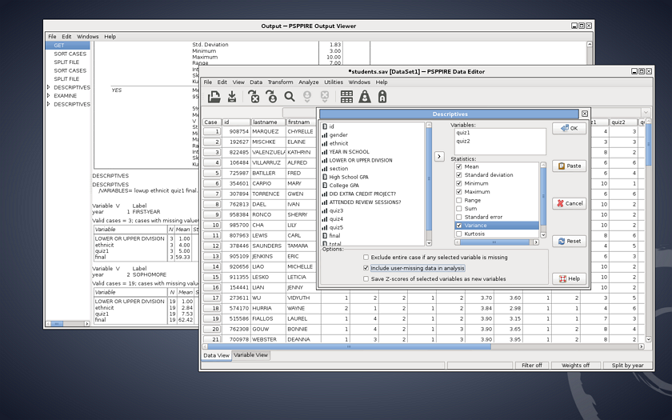

R-bloggers - blog aggregator with statistics articles generally done with R software.Īs a budding data scientist, I love all things statistics except exploratory factor analysis and I can’t wrap my head around why it’s so popular.įor starters, it’s incredibly difficult to find a publicly available software package that can do EFAs with minor headaches. Kaggle Self posts with throwaway accounts will be deleted by AutoModerator Memes and image macros are not acceptable forms of content.

Just because it has a statistic in it doesn't make it statistics. Please try to keep submissions on topic and of high quality. They will be swiftly removed, so don't waste your time! Please kindly post those over at: r/homeworkhelp. This is not a subreddit for homework questions.
PSPP FACTOR ANALYSIS LICENSE
This work is licensed under a Creative Commons Attribution 4.0 International License that allows sharing, adapting, and remixing.All Posts Require One of the Following Tags in the Post Title! If you do not flag your post, automoderator will delete it: Tag Index | Next - Chi Square Goodness of Fit For this example, the results would be reported as F(3, 36) = 66.7, p <. The format for reporting ANOVA results in APA style is F(degrees of freedom - between, degrees of freedom - within) = F score, p = p value. The sums of squares and mean squares results are sometimes used for further analyses, such as calculating effect sizes. This result would be statistically significant because p <. The F score statistic and the p value are shown on the right side. Fortunately, the homogeneity test is not significant for this current example. If the results of this test are significant, it would suggest that the group variances are significantly different, so ANOVA might not be an appropriate test. ANOVA assumes that the groups have variances that are similar. The next part of the output shows the homogeneity of variance test. The output begins with some basic descriptive statistics, such as the mean and standard deviation for each group. This is useful information to have, so let's check these boxes. PSPP also provides check boxes for "descriptives" and "homogeneity". This organization is similar to the dialog box used for the independent-samples t-test.

The variable representing the groups must be moved to the Factor field. The dialog box requires users to select the dependent variable and move it to the central Dependent Variable field. The one-way ANOVA test is started by selecting Analyze, Compare Means, then One-Way ANOVA. The data file is available for downloading. The Group variable has group membership represented by 0, 1, 2, or 3 for a zero, low, medium, or high dose, respectively. The BP variable represents systolic blood pressure. Part of the example data are shown below, with some data omitted to save space. Hypertensive individuals are randomly assigned to groups that get no drug (control), a low dose, medium dose, or high dose. In this example, let's pretend that a drug is being tested to treat high blood pressure. This approach is similar to the setup for an independent-samples t-test.

A second variable is needed to represent the group membership. In PSPP, a one-way ANOVA must have a dependent variable for the data. A more advanced version of ANOVA is available for experiments that have two or more factors. The most basic version of ANOVA compares groups that vary in a single dimension, or factor. A different kind of statistical test must be used if there are three or more groups that need to be compared.Īnalysis of Variance, or ANOVA, was invented by Sir Ronald Fisher to simultaneously compare the results from several groups. The t-test is limited to comparing two groups or conditions. PSPP for Beginners PSPP for Beginners One-Way Analysis of Variance Test


 0 kommentar(er)
0 kommentar(er)
